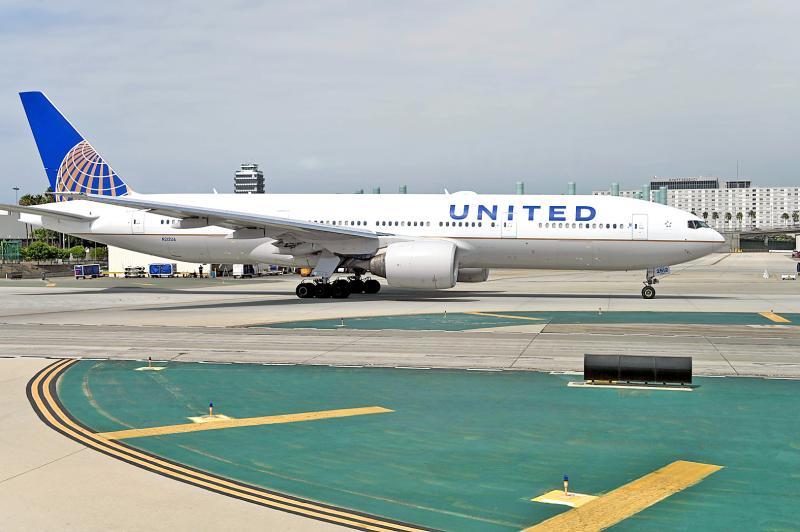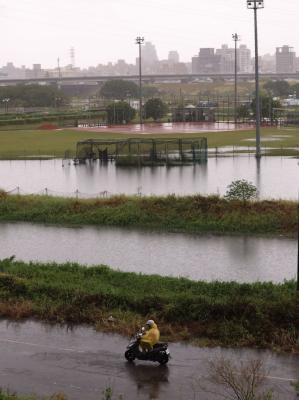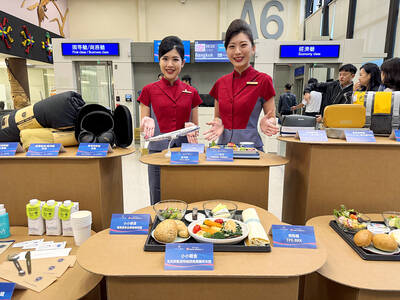United Airlines today launched its new Taipei (Taoyuan)-Guam route, offering twice-weekly flights, while Tigerair Taiwan inaugurated its Taipei (Taoyuan)-Oita service also flying twice a week.
United Airlines operates the new route using a Boeing 737-800 with 166 seats.

Photo: AFP
Departures from Taiwan Taoyuan International Airport are scheduled for 10:30am on Wednesdays and 11am on Saturdays, while return flights from Guam leave at 7am on both days.
To mark the inaugural flight, representatives from the Guam Visitors Bureau and United Airlines visited Taiwan today.
At the Taoyuan airport, they emphasized their joint efforts to promote Guam as a travel destination.
Kenichi Kiriyama, United Airlines' director of sales for Japan, Micronesia, the Philippines and Taiwan, highlighted the airline's long-standing presence in Taiwan since 1986.
Since 2014, the US carrier has transported 2 million passengers between Taoyuan and San Francisco, he said, adding that in addition to the Taipei-Guam route, the airline plans to launch flights from Kaohsiung to Tokyo on July 12.
Meanwhile, Tigerair Taiwan's new Taipei-Oita route makes Oita its 21st destination in Japan and its fourth direct flight to Kyushu, following Fukuoka, Saga and Miyazaki.
The Taipei-Oita service operates twice weekly, with outbound flights departing at 12pm on Wednesdays and Saturdays, and return flights from Oita leaving at 4:30pm the same days, the low-cost airline said.

TRAFFIC SAFETY RULES: A positive result in a drug test would result in a two-year license suspension for the driver and vehicle, and a fine of up to NT$180,000 The Ministry of Transportation and Communications is to authorize police to conduct roadside saliva tests by the end of the year to deter people from driving while under the influence of narcotics, it said yesterday. The ministry last month unveiled a draft of amended regulations governing traffic safety rules and penalties, which included provisions empowering police to conduct mandatory saliva tests on drivers. While currently rules authorize police to use oral fluid testing kits for signs of drug use, they do not establish penalties for noncompliance or operating procedures for officers to follow, the ministry said. The proposed changes to the regulations require

Taipei, New Taipei City, Keelung and Taoyuan would issue a decision at 8pm on whether to cancel work and school tomorrow due to forecasted heavy rain, Keelung Mayor Hsieh Kuo-liang (謝國樑) said today. Hsieh told reporters that absent some pressing reason, the four northern cities would announce the decision jointly at 8pm. Keelung is expected to receive between 300mm and 490mm of rain in the period from 2pm today through 2pm tomorrow, Central Weather Administration data showed. Keelung City Government regulations stipulate that school and work can be canceled if rain totals in mountainous or low-elevation areas are forecast to exceed 350mm in

1.4nm WAFERS: While TSMC is gearing up to expand its overseas production, it would also continue to invest in Taiwan, company chairman and CEO C.C. Wei said Taiwan Semiconductor Manufacturing Co (TSMC) has applied for permission to construct a new plant in the Central Taiwan Science Park (中部科學園區), which it would use for the production of new high-speed wafers, the National Science and Technology Council said yesterday. The council, which supervises three major science parks in Taiwan, confirmed that the Central Taiwan Science Park Bureau had received an application on Friday from TSMC, the world’s largest contract chipmaker, to commence work on the new A14 fab. A14 technology, a 1.4 nanometer (nm) process, is designed to drive artificial intelligence transformation by enabling faster computing and greater power

China Airlines Ltd (CAL) yesterday morning joined SkyTeam’s Aviation Challenge for the fourth time, operating a demonstration flight for “net zero carbon emissions” from Taiwan Taoyuan International Airport to Bangkok. The flight used sustainable aviation fuel (SAF) at a ratio of up to 40 percent, the highest proportion CAL has achieved to date, the nation’s largest carrier said. Since April, SAF has become available to Taiwanese international carriers at Taipei International Airport (Songshan airport), Kaohsiung International Airport and Taoyuan airport. In previous challenges, CAL operated “net zero carbon emission flights” to Singapore and Japan. At a ceremony at Taoyuan airport, China Airlines chief sustainability